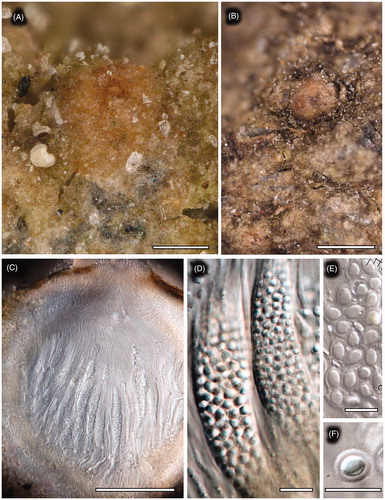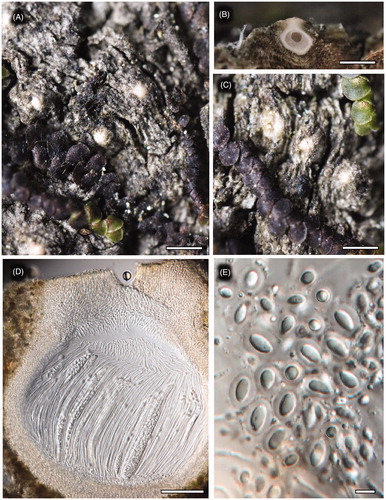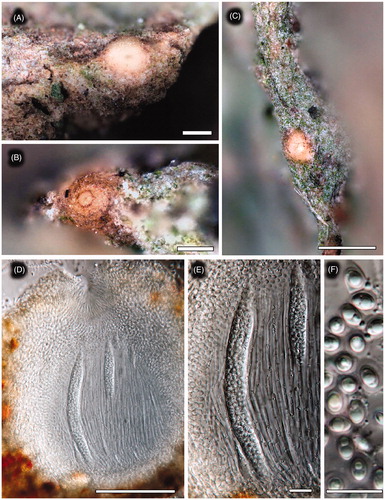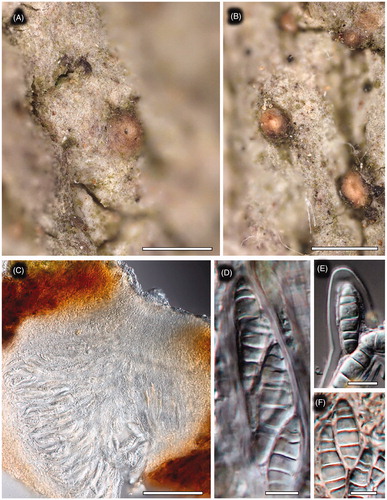Abstract
Two new species, Thelopsis ullungdoensis and Phylloblastia gyeongsangbukensis are described from Ullung-Do (Island), South Korea. The closest relatives from Europe and Korea are epiphytic Thelopsis flaveola which differs by their immersed or semi-immersed yellow ascomata, ascospores without halo and their habitat of smooth bark (mainly Fagus) in humid and cold climates. Thelopsis gangwondoensis differs by its bigger semi-immersed ascomata (600–700 µm in diam.), oblong halonate ascospores (8–12 × 6–8 µm) and its habitat of smooth bark of deciduous trees. P. gyeongsangbukensis differs from its relatives within the genus in having 5-septate ascospores (22–26 × 6–8 µm), semi-immersed, subglobose ascomata with a flattened top (250–400 µm) and a thin, matt, uneven gray-brown to gray-green continuous thallus without isidia.
1. Introduction
The genus Thelopsis (Ostropales, Stictidaceae, 16 species) is widespread in both hemispheres in tropical and temperate regions. Most of the corticolous taxa are known from soft bark of old trees, saxicolous taxa are endolitic and epilithic on siliceous and limestone rocks. A recent overview of the genus has been compiled [Citation1]. Four epiphytic species, Thelopsis chirisanensis, Thelopsis gangwondoensis, Thelopsis loekoesii, and Thelopsis muriformis were described from Korea [Citation2–5] and a saxicolous species not included in [Citation1] is known from Africa [Citation6]. Species of Thelopsis form globose, perithecioid ascomata, a hymenium with paraphyses and periphyses, and multispored or polysporic asci. Ascospores usually have one or more septa. Several species are known from type locality only.
The foliicolous genus Phylloblastia (Verrucariales, Verrucariaceae, 16 species) is widespread in the Neotropics [Citation7], Europe [Citation8], Australia [Citation9], and Africa [Citation10]. Phylloblastia is very close to Psoroglaena but is distinguished by its crustose ecorticate thallus, photobiont chlorococcoid with angular-rounded cells in irregular groups, asci with broad ocular chamber and hemispherical to subglobose ascomata with flattened top [Citation11]. No member of this genus is known from South Korea yet.
The genus Psoroglaena (Verrucariales, Verrucariaceae, 21 species) is widespread in temperate, subtropical, and tropical regions of the world [Citation12]. Psoroglaena is very close to Phylloblastia but differs in having a filamentous, granulose, or crustose thallus, pale yellowish, to blackish perithecia without or with only reduced involucrellum and colorless, transversely septate to muriform ascospores [Citation11].
Four species of the genus Psoroglaena are known from South Korea Psoroglaena chirisanensis [Citation2], P. coreana [Citation4], P. gangwondoensis [Citation3], and P. sunchonensis [Citation13].
During the researches on lichen diversity in Ullung Island in the East Sea of Korea (Sea of Japan), two new species are discovered, and their morphology, chemistry, ecology, and illustration are given in this study.
2. Materials and methods
Specimens were examined with a stereo and/or compound microscope, and chemical spot tests were conducted by para-phenylenediamine in ethyl alcohol, nitric acid, sodium hypochlorite, 10% potassium hydroxide, and Lugol’s iodine. The chemistry of the type specimens was investigated by spot reactions with K, C, and P, and thin-layer chromatography (TLC) using solvent C [Citation14]. Macro images were captured with a Canon 5DSR digital SLR camera mounted on Olympus Zuiko 20 mm macro lens. Microscopic images were captured with a Canon 5DSR digital SLR camera mounted on Olympus BX41 DIC microscope. Illustrations were prepared using Adobe Photoshop. Measurements of the hymenium, hypothecium, cortex, and spore size (30–50 spores per specimen) were made in water mounts. Voucher specimens were deposited in the Korean Lichen Research Institute, Sunchon National University, Suncheon, South Korea.
3. Result
3.1. Thelopsis ullungdoensis J.P. Halda, D. Liu, and J.-S. Hur, sp. nov.
MycoBank MB 834475
Figure 1. Thelopsis ullundoensis (KoLRI 39215 HOLOTYPUS), Korea, Ullung-do, Gyeongsangbuk-do, Ullung-gun, Sadong-ri, N37°29′34,55′′130°52′55,05′′, 612 m, on basalt, 8. 7. 2016, col. J. Halda. Photo J. Halda 2019; (A, B) thallus with ascomata; (C) vertical section of an ascoma; (D) ascus with ascospores; (E, F) ascospores, mounted in water; Scales: A, C – 100 μm, B – 500 μm, D, E, F – 10 μm.

Thelopsis ullungdoensis differs in having simple ascospores (2–3 × 3–4 µm) with a distinct halo (1 µm), small orange-brown ascomata (200–400 µm) and thin, matt, uneven orange-brown thallus without areoles ().
Type
South Korea, Gyeongsangbuk-do (Prov.), Ullung-do (Island), Ullung-gun (County), Sadong-ri, 37°29′34.55″N, 130°52′55.05″E, 612 m, on shaded volcanic rock, July 8 2016, J. Halda, J.S. Park, and D. Liu (KoLRI 039215, holotype).
Etymology
The epithet “ullundoensis” refers to Ullung-do(Island), the type locality.
Morphology
Thallus saxicolous, thin, matt, smooth, crustose, orange-brown, finely cracked non-areolate, 50–100 µm thick, not surrounded by prothallus. Photobiont Trentepohlia.
Perithecia numerous, dispersed, emerging from thallus, globose to pyriform, 200–400 µm in diam., covered by thalline layer at base; ostiole distinct (20–30 µm) as a red-brown ring (under microscope). Excipulum brownish on the upper part of the ascoma and around the ostiole, 400–500 µm thick. Hymenium not inspersed, KI + pale blue; paraphyses simple, not septate, unbranched, sparse, apices not swollen (120 × 1.5 µm); periphyses unbranched, numerous, 5–10 µm long. Asci containing more than 100 ascospores, 80–90 × 15–25 µm. Ascospores hyaline, simple, globose to ellipsoid, 2–3 × 3 µm, with distinct halo (1 µm wide). Pycnidia not observed.
Chemistry
All the spot tests were negative and no substances were detected by TLC.
Ecology and distribution
On shaded basalt rock in deciduous forest. Known only from Ullung-Do (Island). It grows together in association with Gyalidea austrocoreana and Verrucaria gongshanensis.
Remarks
The epiphytic Thelopsis flaveola Arnold is known from Europe and North America. Its occurrences are restricted to old-growth forest stands where it is used as a significant bioindicator of ecological forest continuity [Citation15]. According to the description in monography [Citation16], it differs in the size of the ascospores (4–6 × 3–4 µm) and distinctly septate paraphyses (). The closest relatives known from Europe and USA, T. flaveola (), differ by their immersed to semi-immersed yellow ascomata [Citation17], round ascospores without halo (4–6 × 3–4 µm) and their habitat of smooth bark (mainly Fagus) in humid and cold climates. The recently described epiphytic T. gangwondoensis from Korea () [Citation3], differs by its bigger white semi-immersed ascomata (600–700 µm in diam.), ascospores (8–12 × 6–8 µm), and its habitat of smooth bark of deciduous trees.
Figure 2. Thelopsis gangwondoensis (KoLRI 39852), Korea, Gyeongsangnam-do, Sancheong-gun, Sicheon-myeon, Naedae-ri, Jiri Mts, N35°17′14,80′′E127°42′33,27′′ , 777 m, on bark of deciduous tree, 30. 6. 2016, col. J. Halda. Photo J. Halda 2019; (A–C) thallus with ascomata; (D) vertical section of an ascoma; (E) ascospores, mounted in water; Scales: A–C – 100 μm, D, E – 10 μm.

Figure 3. Thelopsis flaveola (ZP27773), Europe, W Carpathians, Muráňska planina plateau: Velká Stožka nature reserve, Mt. Velká Stožka – SW foothill, beech dominated forest on WSW facing slope, N48°46′18,9′′E19°56′26,6′′ , 975 m, on weathered bark of old Fagus, 8. 10. 2019, col. D. Blanár, A. Guttová, J. Halda, & Z. Palice. Photo J. Halda 2020; (A–C) thallus with an ascoma; (D) vertical section of an ascoma; (E) ascus with ascospores; (F) ascospores, mounted in water; Scales: A, B, D – 100 μm, C – 500 μm, E, F – 10 μm.

Key to the species of the genus Thelopsis in Korea
Ascospores simple 2
– Ascospores septate 3
Ascospores round, 2–3 × 3–4 µm, grows on rockThelopsis ullundoensis
– Ascospores oblong, 8–12 × 6–8 µm, on barkThelopsis gangwondoensis
Ascospores >4 septate4
– Ascospores 3 septate, 16–21 × 4–5 µm, on barkThelopsis loekoesii
Ascospores muriform, 17–20 × 8–10 µm, with 10–16 locules in optical view, on barkThelopsis muriformis
– Ascospores submuriform, 13–17 × 6.5–7 µm, with 4–7 locules in optical view, on barkThelopsis chirisanensis
Key to the species of the genus Psoroglaena in Korea
Thallus on bark 2
– Thallus on rocks 4
Ascospores 1–3 septate, narrowly ellipsoid, with constrictions at the septa, 18–20 × 5.5–6.5 µm Psoroglaena chirisanensis
– Ascospores submuriform 3
Ascospores submuriform, central cell especially wide, with 3–5–7 transverse septa and 1–2 cells with a single longitudinal septum, 22–29 × 7–9 P. gangwondoensis
– Thallus epiphytic, bright green granules in wet conditions, ascospores submurifom, with 3–5 transverse septa and only one or two cells in the central line with a single longitudinal septum, 14–18 × 8–9 µm P. sunchonensis
Ascospores 3-septate, 18–22 × 5.5–6.5 µm P. coreana
– Ascospores 3-septate, 13–17 × 5–6 µm Psoroglaena japonica
3.2. Phylloblastia gyeongsangbukensis J.P. Halda, J.S. Park, and J.-S. Hur, sp. nov
MycoBank MB 834476
Phylloblastia gyeongsangbukensis differs in having 5-septate ascospores (22–26 × 6–8 µm, three times as long as they are broad), semi-immersed, subglobose with a flattened top ascomata (250–400 µm) and thin, matt, uneven gray-brown to gray-green continuous thallus without isidia ().
Figure 4. Phylloblastia gyeongsangbukensis (KoLRI 39225 HOLOTYPUS), Korea, Ullung-do, Gyeongsangbuk-do, Ullung-gun, Ullung-eup, Sadong-ri, N37°29′20,65′′E130°53′20,59′′, 479 m, on bark, 8. 7. 2016, col. J. Halda. Photo J. P. Halda 2019; (A, B) thallus with ascomata; (C) vertical section of an ascoma; (D) ascus with ascospores; (E, F) ascospores, mounted in water; Scales: A, B – 500 μm, C – 100 μm, D–F – 10 μm.

Type
South Korea, Gyeongsangbuk-do (Prov.), Ullung-gun (County), Ullung-do (Island), Sadong-ri, 37°29′20.65″N, 130°53′20.59″E, 479 m, on bark of deciduous tree, July 8 2016, J.P. Halda, J.S. Park, and D. Liu (KoLRI 039225, holotype).
Etymology
The epithet “gyeongsangbukensis” refers to part of Ullung-do (Island), the type locality.
Morphology
Thallus epiphytic, smooth, 40–50 µm thick, greenish gray, composed of hyaline, interwoven hyphae, 3–4 µm wide. Photobiont chlorococcoid, algal cells 8–12 µm diam., forming irregular aggregates surrounded by fungal hyphae.
Perithecia from one-half semi immersed, subglobose with depressed top, 250–400 µm diam., up to 200 µm high, pinkish brown. Involucrellum paraplectenchymatous, 25–35 µm thick, pale to dark brown, extending to excipulum base level. Excipulum hyaline to pale brown, 15–20 µm thick, consisting of elongate, thin-walled periclinal hyphae. Subhymenium 15–20 µm thick. Paraphyses absent. Periphyses sparingly branched, 10–30 × 1–2 µm, colorless, made up of one basal layer of isodiametric cells (4–6 µm thick) and oblong apical cells (5–10 × 1.5–2 µm). Asci fissitunicate, clavate, 8-spored, 55–80 × 15–25 µm (n = 35), usually with a broad, truncate, or convex ocular chamber, ascus apex slightly thickened. Ascospores ellipsoid to fusiform, with round ends, straight with one end wider, 5 transverse septate, without constrictions at the septum, one of the central cell 22–26 × 6–8 µm, three times as long as broad (n = 50). Pycnidia not found.
Ecology and distribution
P. gyeongsangbukensis grows on bark of shaded stems of deciduous trees in association with Dictyocatenulata alba.
Remarks
Psoroglaena gangwondoensis has sessile ascomata without involucrellum, ascospores with 3–7 transverse septa, with constrictions at the septum, and some cells with a single longitudinal septum, 22–29 × 7–9 µm. The closest relatives recently described from Europe, P. inexpectata Sérus., Coppins & Lücking, are foliicolous lichen which differ by their 3-septate ascospores (14–16 × 4.5–5 µm) [Citation18]. Psoroglaena laevigata Lücking from the Neotropics differs by its sparsely isidiate, dark olive to brownish-green thallus with prothallus and disc-shaped isidia, brown-black and smaller ascomata (to 250 µm in diam.) and fusiform to ellipsoid, 3–5-septate ascospores, 22–28 × 5–7 µm, 4–4.5 times as long as they are broad [Citation11]. Psoroglaena gangwondoensis S. Y. Kondr., L. Lőkös, J.-J. Woo, & J.-S. Hur [Citation3] differs in having superficial ascomata without an involucrellum, in having much larger algal cells, in having a much thicker exciple not consisting of two distinct layers, in having ascospores with 3–5–7 transverse septa and (0–)1–2 cells with a single longitudinal septum, ascospores with constrictions at the septum. P. stigonemoides has a filamentous thallus and ascospores 3–5 septate 16–21 × 5–6 µm. Psoroglaena dictyospora differs in its finely granular to verrucose thallus, composed of isodiametric goniocysts. Some species of foliicolous Phylloblastia also have 3–7 septate ascospores, they differ in size. P. blechnicola has 3–6 septate spores 25 × 5 µm, P. inexpectata, P. borhidii, and P. triseptata have 3-septate ascospores. P. amazonica, P. bielczyckiae, and P. dolichospora have submuriform to muriform ascospores.
4. Discussion
A surprising number of unknown lichens have been found on a small island during the three year research (Acarospora ulleungdoensis, Buellia ulleungdoensis, Catillaria ulleungdoensis, Gyalecta ulleungdoensis, Opegrapha ulleungdoensis, Porina ulleungdoensis, Porpidia ulleungdoensis, Rufoplaca ulleungensis, Sarcogyne ulleungdoensis, and Thelocarpon ulleungdoense) [Citation3–5,Citation13,Citation19]. This may be due to the considerable geographical isolation, the great diversity of habitats, and the remarkable fragmentation of the island.
Acknowledgments
The authors thank Dr. Zdeněk Palice for loaning the sample Thelopsis flaveola. Simon ÓFlynn corrected the English.
Disclosure statement
No potential conflict of interest was reported by the authors.
Additional information
Funding
References
- Aptroot A, Mendonça CO, Ferraro LI, et al. A world key to species of the genera Topelia and Thelopsis (Stictidaceae), with the description of three new species from Brazil and Argentina. Lichenologist. 2014;46(6):801–807.
- Kondratyuk SY, Lőkös L, Halda JP, et al. New and noteworthy lichen-forming and lichenicolous fungi 4. Acta Bot Hungar. 2016;58(1–2):75–136.
- Kondratyuk SY, Lőkös L, Halda JP, et al. New and noteworthy lichen-forming and lichenicolous fungi 7. Acta Bot Hungar. 2018;60(1–2):115–184.
- Kondratyuk SY, Lőkös L, Halda JP, et al. New and noteworthy lichen-forming and lichenicolous fungi 5. Acta Bot Hungar. 2016;58(3–4):319–396.
- Kondratyuk SY, Halda JP, Lőkös L, et al. New and noteworthy lichen-forming and lichenicolous fungi 8. Acta Bot Hungar. 2019;61(1–2):101–135.
- Ppg van den B. Additions and notes to the checklist of lichens and lichenicolous fungi of Cape Verde. Österr Z Pilzk. 2012;21:5–16.
- Flakus A, Lücking R. New species and additional records of foliicolous lichenized fungi from Bolivia. Lichenologist. 2008;40(05):423–436.
- Llop E, Gómez-Bolea A. The lichen genus Phylloblastia (Verrucariaceae) in the Iberian Peninsula, with a new species from Western Europe. Lichenologist. 2009;41(6):565–569.
- McCarthy PM. New and interesting foliicolous lichens from Australia. Austr Lichenol. 2010;66:4–15.
- Broeck D, van den Lücking R, Ertz D. The foliicolous lichen biota of the Democratic Republic of the Congo, with the description of six new species. Lichenologist. 2014;46(2):141–158.
- Lücking R. Foliicolous lichenized fungi. Flora Neotrop. 2008;103:1–867.
- McCarthy PM, Kantvilas G. Psoroglaena halmaturina sp. nov. (Lichenised ascomycota, Verrucariaceae) from Kangaroo Island, South Australia. J Adelaide Bot Gardens. 2013;26:1–4.
- Kondratyuk SY, Lőkös L, Halda JP, et al. New and noteworthy lichen-forming and lichenicolous fungi 6. Acta Bot Hungar. 2017; 59(1–2):137–260.
- Orange A, James PW, White FJ. Microchemical methods for the identification of lichens. London: British Lichen Society; 2001. p. 101.
- Dymytrova L, Nadyeina O, Naumovych A, et al. Primeval beech forests of Ukrainian Carpathians are sanctuaries for rare and endangered epiphytic lichens. Herzogia. 2013;26(1):73–89.
- Vězda A. Taxonomische Revision der Gattung Thelopsis Nyl. (Lichenisierte Fungi). Folia Geobot Phytotax. 1968;3(4):363–406.
- Renobales G, Barreno E, Atienza V. Thelopsis foveolata, a new lichen from northern Spain. Lichenologist. 1996;28(2):105–111.
- Sérusiaux E, Coppins BJ, Lücking R. Phylloblastia inexpectata (Verrucariaceae), a new species of foliicolous lichen from Western Europe and Madeira. Lichenologist. 2007;39(2):103–108.
- Kondratyuk SY, Lőkös L, Farkas E, et al. New and noteworthy lichen-forming and lichenicolous fungi 9. Acta Bot Hungar. 2019;61(3–4):325–367.
